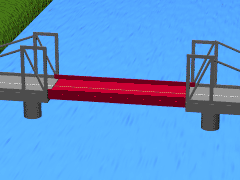Loading AI tools
Type of movable bridge From Wikipedia, the free encyclopedia
A vertical-lift bridge or just lift bridge is a type of movable bridge in which a span rises vertically while remaining parallel with the deck.
 An animation showing how a vertical-lift bridge operates with vehicular and shipping traffic | |
| Ancestor | Truss bridge |
|---|---|
| Related | Bascule bridge, swing bridge, folding bridge, retractable bridge |
| Descendant | Submersible bridge, table bridge |
| Carries | Automobile, pedestrians, truck, light rail, heavy rail |
| Span range | Short |
| Material | Steel |
| Movable | Yes |
| Design effort | medium |
| Falsework required | Depends upon degree of prefabrication |
The vertical lift offers several benefits over other movable bridges such as the bascule and swing-span bridges. Generally speaking, they cost less to build for longer moveable spans.[1] The counterweights in a vertical lift are only required to be equal to the weight of the deck, whereas bascule bridge counterweights must weigh several times as much as the span being lifted. As a result, heavier materials can be used in the deck, and so this type of bridge is especially suited for heavy railroad use. The biggest disadvantage to the vertical-lift bridge (in comparison with many other designs) is the height restriction for vessels passing under it, due to the deck remaining suspended above the passageway.
Most vertical-lift bridges use towers, each equipped with counterweights. An example of this kind was built in Portland, Oregon, United States in 1912.
Another design uses balance beams to lift the deck, with pivoting bascules located on the top of the lift towers.[2]
Seamless Wikipedia browsing. On steroids.
Every time you click a link to Wikipedia, Wiktionary or Wikiquote in your browser's search results, it will show the modern Wikiwand interface.
Wikiwand extension is a five stars, simple, with minimum permission required to keep your browsing private, safe and transparent.